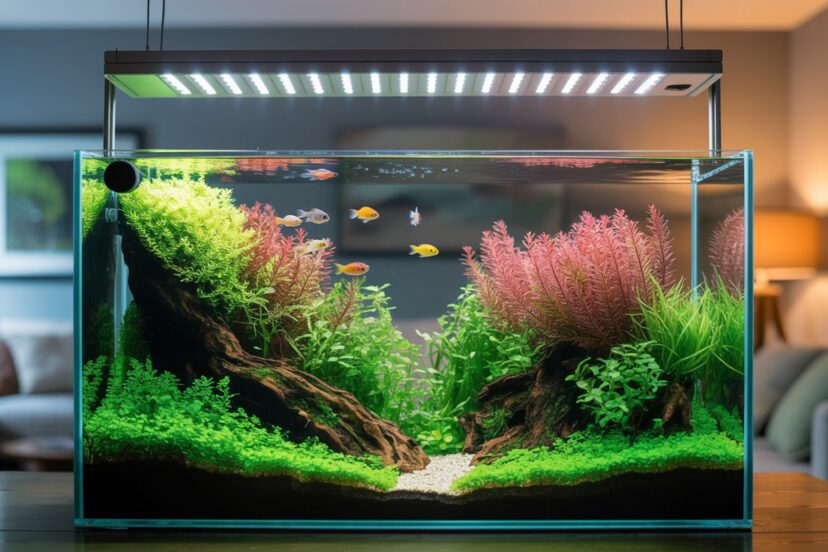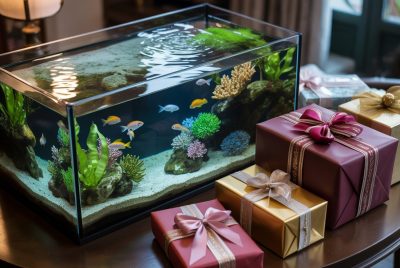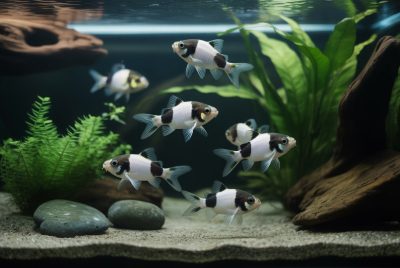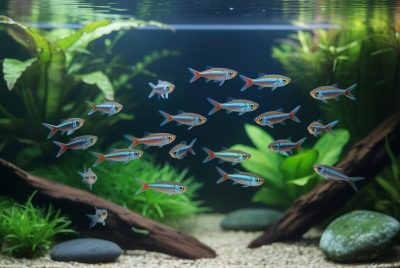Best LED Lights for Planted Tanks
*We may earn a commission for purchases made using our links. Please see our disclosure to learn more.
The day I switched from my standard aquarium light to a specialized planted tank LED was nothing short of transformational. My lackluster aquascape suddenly burst into vibrant greens, my struggling plants began reaching upward with newfound energy, and the entire underwater ecosystem seemed to awaken. What had been a constant battle against algae and plant melt became a harmonious garden that largely maintained itself. That moment changed everything about my approach to the aquarium hobby.
If you’re reading this, you’re likely somewhere on your own planted tank journey—perhaps struggling with leggy growth, battling stubborn algae, or simply wanting to elevate your underwater landscape to the next level. The truth is, proper lighting isn’t just another equipment checkbox; it’s the foundation upon which your entire aquatic garden thrives or fails.
In this guide, I’ll walk you through my own illuminating journey (pun absolutely intended) with planted tank lighting. I’ll share the mistakes that cost me both money and frustration, the transformations I’ve witnessed across different tank setups, and the specific LED lighting solutions that finally helped me create the lush underwater paradise I’d been envisioning. Whether you’re setting up your first planted nano tank or upgrading a seasoned aquascape, this comprehensive lighting guide will help you make informed decisions that benefit both your plants and your wallet.
“The right lighting doesn’t just grow plants; it reveals the living artwork you’ve created beneath the water’s surface.”
— Aquatic Plant Central
Key Takeaways
- Spectrum matters: Plants require specific light wavelengths (primarily red and blue) for optimal photosynthesis and growth patterns
- PAR, not watts: Focus on PAR (Photosynthetically Active Radiation) values rather than wattage when selecting planted tank lighting
- Match to plant needs: Different plant species require different light intensities—categorize your plants as low, medium, or high light before selecting fixtures
- Proper duration: Even the best LED light can cause algae problems if left on too long (8-10 hours is ideal for most setups)
- Features worth investing in: Dimmability, programmable schedules, and customizable spectrums offer greater control over your tank’s ecosystem
Recommended LED Lights for Planted Tanks
1. Fluval Plant 3.0 LED
The Fluval Plant 3.0 LED is a high-performance aquarium light designed for planted tanks, offering full-spectrum illumination to enhance plant growth and aquarium aesthetics. With customizable 24-hour light cycles and six unique band waves, this light provides optimal lighting conditions for a thriving aquatic environment. Its extendable mounting brackets ensure easy installation, making it a versatile choice for various tank sizes.
The Fluval is best suited for medium to high-tech planted tanks. It features Bluetooth control, a customizable light spectrum, realistic sunrise and sunset simulation, and a wide 120° light dispersion. I recommend it because, after struggling with uneven growth in my 40-gallon tank, switching to the Fluval transformed its appearance almost overnight. The ability to set different light periods throughout the day has greatly reduced algae and promoted healthier, more balanced plant growth.
- Customizable Lighting: Features programmable 24-hour cycles, including sunrise, midday, sunset, and night modes.
- Full Spectrum Growth: Six unique band waves promote healthy plant growth and vibrant colors.
- Wide Coverage: 120-degree light dispersion ensures even illumination across the entire tank.
- Premium Price: Higher cost compared to basic aquarium lighting options.
- App-Dependent Controls: Requires a mobile app for full customization, which may not suit all users.
- Limited Waterproofing: Not fully submersible, so care is needed during maintenance.
2. Finnex Planted+ 24/7 HLC
The Finnex Planted Plus 24/7 HLC Aquarium LED Light is designed to provide a full-spectrum lighting experience, promoting healthy plant growth with its True 660nm Deep Red LEDs. Featuring an automated 24/7 mode, it simulates natural sunrise and sunset transitions, creating a realistic day-night cycle for your aquarium. With a sleek aluminum design and remote-controlled customization, this light is perfect for aquascapers and planted tank enthusiasts looking for both functionality and style.
NICREW SkyLED Plus is best for low to medium light plants and smaller tanks. It offers a 24/7 mode that simulates a natural daylight cycle, a memory function to retain settings, and separate controls for day and night lighting. I recommend it because it was my first serious planted tank light, and it’s still one of the best options for beginners. The pre-programmed settings make it easy to use without constant adjustments, so you can focus more on enjoying your tank than on tweaking light parameters.
- Full-Spectrum Lighting: Enhances plant growth with deep red, blue, green, and daylight LEDs.
- 24/7 Automated Mode: Simulates natural sunrise and sunset for a realistic day-night cycle.
- Sleek & Durable Design: Aluminum body provides a polished, modern look while ensuring longevity.
- Remote-Dependent Control: Settings cannot be adjusted manually without the remote.
- Limited Water Resistance: Not fully waterproof, so precautions are needed near water.
- Brightness May Need Adjustment: Some users may find it too bright for low-light plants or sensitive fish.
3. Chihiros WRGB II
Elevate your aquarium setup with the Chihiros WRGB II PRO LED Aquarium Light, a full-spectrum light designed to meet the needs of both aquatic plants and freshwater fish. Equipped with Bluetooth and the "My Chihiros App," this light allows for precise control of red, green, and blue color channels, ensuring vibrant plant growth and a natural light cycle for your aquatic environment. Offering up to 11,170 lumens, it is perfect for demanding plants and ensures optimal light conditions for your tank. The sleek black finish and stainless steel adjustable legs provide both elegance and durability, while the high-performance LED technology guarantees energy efficiency. Available in various sizes to match your aquarium dimensions, this light is a must-have for aquarium enthusiasts.
This light is best for high-tech planted tanks and aquascapers who prioritize aesthetics. It features ultra-high color rendering, app control, a sleek and slim profile, and advanced RGB+W technology. I recommend it because nothing enhances plant colors quite like this light. When I upgraded to it for my display tank, visitors regularly remarked on how vibrant and “alive” the aquarium looked. The ultra-thin design also ensures the focus stays on your aquascape, not the lighting fixture.
- Customizable Lighting: Bluetooth control with full spectrum and adjustable light settings for optimal growth.
- Powerful Performance: High-lumen output and efficient LED technology for vibrant plant growth.
- Sleek Design: Modern black finish with adjustable stainless steel legs for stability and style.
- Higher Price Point: Premium features come with a premium price tag.
- Complex Setup: Requires the "My Chihiros App" for full control, which may take time to get used to.
- Limited Size Options: Available sizes may not fit all tank setups without additional adjustments.
4. Nicrew SkyLED Plus
The NICREW SkyLED Plus Aquarium Plant Light is a powerful and versatile lighting solution for freshwater planted tanks. Designed with a full spectrum blend of 6500K white, 450nm blue, and 660nm red LEDs, it promotes healthy plant growth and vibrant aquarium visuals. With an upgraded LCD controller, users can easily set lighting schedules, adjust brightness, and simulate natural sunrise and sunset with ramp-up and dim-down settings. The adjustable mounting brackets make it suitable for a range of tank sizes, and the fully sealed fixture ensures durability against splashes and humidity.
This light is best for budget-conscious hobbyists and low to medium light setups. It offers adjustable brightness, a built-in timer function, and a spectrum well-suited for plant growth. I recommend it because not everyone wants to spend a fortune on aquarium lighting, and this fixture proves you don’t have to. I use these on my propagation tanks and have seen impressive growth without the high price tag.
- Spectrum Quality: Full spectrum lighting with red, blue, and white LEDs supports optimal plant photosynthesis.
- Custom Scheduling: Programmable controller with sunrise/sunset simulation adds a natural touch to lighting cycles.
- Ease of Installation: Adjustable legs fit various tank sizes for quick and hassle-free setup.
- Controller Learning Curve: May take time to understand and program for beginners.
- Not Submersible: Water-resistant but not waterproof—must stay above water.
- Limited to Freshwater: Not ideal for saltwater reef setups or tanks with high lighting needs.
My Journey into Planted Tank Lighting
My first planted tank was, frankly, a disaster. Armed with the stock LED that came with my aquarium kit, I loaded my tank with beautiful (and expensive) plants, expecting a lush underwater paradise. Within weeks, most plants were yellow, leggy, or completely melted away. The few survivors stretched desperately toward the surface while an aggressive green film coated every surface.
“Plants just need light, right?” That simplistic thinking cost me hundreds of dollars in failed vegetation and countless hours scrubbing algae. The pivotal moment came when a fellow hobbyist at my local aquarium club took one look at my setup and shook their head. “Your light isn’t growing plants,” they explained, “it’s just growing algae.”
That conversation launched me into researching the science behind aquarium lighting. I discovered that the intensity, spectrum, and duration of light all play crucial roles in plant health. More importantly, I learned that not all LED lights are created equal—especially when it comes to growing living plants underwater.
Understanding Light Spectrum and Plant Needs
The revelation that transformed my tanks was understanding that plants don’t use all wavelengths of light equally. While our eyes prefer the bright white light that makes tanks “pop” visually, plants primarily utilize red (for flowering and robust growth) and blue (for vegetative growth and compact form) wavelengths.
The first specialized planted tank LED I purchased highlighted this difference immediately. Despite appearing less bright to my eyes than my previous light, my plants responded with explosive growth. Stems that had been struggling began putting out new leaves every few days. Ground cover that had been sparse started carpeting. The difference wasn’t more light—it was the right light.
This experience taught me that the perfect planted tank light provides:
- Peak emissions in the red (630-660nm) and blue (400-470nm) ranges
- Enough green light (500-580nm) to make colors appear natural to our eyes
- Sufficient PAR (Photosynthetically Active Radiation) at the substrate level for your specific plants
When shopping for LEDs, I now look beyond marketing claims and focus on spectral graphs and PAR data. A light that provides the right wavelengths at sufficient intensity will grow beautiful plants while minimizing algae issues.
Matching Light to Your Plant Selection
One of my most expensive mistakes was treating all aquatic plants as if they had identical light requirements. After killing several batches of supposedly “easy” plants, I finally categorized my plants by their light needs:
Low Light Plants
These hardy species thrived even under my moderate lighting setups:
- Anubias varieties
- Java Fern
- Cryptocoryne wendtii
- Bucephalandra species
- Most mosses
Medium Light Plants
These became the backbone of my displays once I upgraded to proper planted tank LEDs:
- Vallisneria
- Amazon Swords
- Most Cryptocoryne species
- Hygrophila polysperma
- Bacopa monnieri
High Light Plants
These demanding beauties only succeeded after I invested in premium lighting:
- Dwarf hairgrass
- Cuba
- Most red plants (Ludwigia, Rotala)
- Carpet plants like Monte Carlo
- Stem plants requiring red coloration
Understanding these categories transformed my approach to aquascaping. Instead of fighting to keep high-light plants alive in inadequate conditions, I began designing layouts around plants suited to my lighting capabilities. When I eventually upgraded my lighting, I did so with specific plants in mind.
The Technical Side: PAR, Lumens, and Kelvin
The technical aspects of lighting initially intimidated me, but understanding a few key metrics helped me make better purchasing decisions:
PAR (Photosynthetically Active Radiation)
This measures the light wavelengths plants actually use for photosynthesis. I learned that:
- Low light plants typically need 15-30 PAR at substrate
- Medium light plants require 30-50 PAR
- High light plants demand 50+ PAR (sometimes well over 100 for certain species)
After measuring the PAR output of my various lights at different depths, I began to understand why certain plants struggled in specific tanks. My 24-inch deep aquarium simply wasn’t getting enough light to the bottom with my original fixture, regardless of how bright it seemed.
Kelvin Rating
While less important than PAR, the Kelvin rating (color temperature) affects both plant growth and visual appearance:
- 6500K-7000K provides balanced growth and a natural appearance
- Lower ratings (5000K) produce warmer, yellower light
- Higher ratings (9000K+) create cooler, bluer appearances
I found that lights in the 6500-7000K range provided the best balance between aesthetic appeal and plant performance. However, many modern LEDs allow adjustment of color temperature, giving the best of all worlds.
Common Lighting Challenges and Solutions
Challenge 1: Uneven Growth Patterns
My first planted tank had lush growth near the light but bare spots in corners and edges. I tried several solutions:
- Multiple light fixtures to eliminate shadows
- Lights with wider beam angles (120° or more)
- Strategic placement of plants based on light needs
- Light-reflecting backgrounds
The most effective solution was upgrading to LEDs with better beam spread, which evenly distributed light across the entire tank footprint.
Challenge 2: Algae Outbreaks
Balancing enough light for plants without fueling algae was a constant struggle. I eventually conquered it by:
- Implementing a proper photoperiod (8 hours for most tanks)
- Using programmable ramp-up and ramp-down periods
- Matching nutrient dosing to light intensity
- Adding floating plants to tanks with very high light requirements
The single most effective change was implementing a 1-2 hour “siesta” period mid-day, turning lights off completely. This disrupted algae growth while plants continued to thrive.
Challenge 3: Cost vs. Performance
Premium lighting meant premium prices, which stretched my budget. I learned to:
- Focus quality lighting on display tanks while using budget options for grow-out tanks
- Purchase lights with upgradeable features rather than replacing entire units
- Consider the long-term electricity costs (efficient LEDs pay for themselves)
- Look for lights that grow the specific plants I wanted rather than the absolute brightest option
The Nicrew lights mentioned earlier became my budget solution for tanks where visual perfection wasn’t the primary goal, allowing me to save for premium lights on my showcase aquarium.
Creating a Balanced Lighting Schedule
Through trial and error, I discovered that even the perfect light could cause problems if run on an improper schedule. My current approach includes:
- Morning Phase (2 hours): Gradual ramp-up from 20% to 70% intensity, emphasizing blue tones
- Midday Phase (4-5 hours): Full intensity with balanced spectrum
- Afternoon Phase (2 hours): Decreased intensity (60-70%) with increased red tones
- Evening Phase (1 hour): Gradual dimming with warm tones before complete shutdown
This schedule mimics natural daylight progressions and gives both plants and fish natural behavioral cues. Most importantly, it limits the peak intensity period when algae is most likely to proliferate.
Many modern LED fixtures can be programmed to follow such schedules automatically, making maintenance much simpler. For budget setups, even a basic timer creating a shorter photoperiod has dramatic benefits.
Beyond the Basics: Advanced Lighting Techniques
As my planted tank obsession grew, I began experimenting with more advanced lighting approaches:
Supplemental Red Lighting
Adding dedicated red LEDs to my setup during specific periods enhanced red plant coloration dramatically. My Ludwigia species, which had always been more orange than red, developed deep crimson hues within weeks of adding supplemental red lighting in the 660nm range.
Dawn/Dusk Simulation
Programming gradual light transitions rather than abrupt on/off cycles reduced fish stress and created more natural behavior patterns. I noticed increased spawning activity in several species after implementing dawn/dusk periods.
Moonlight Settings
Low-intensity blue LEDs during nighttime hours allowed for viewing nocturnal behaviors without disturbing the tank’s day/night cycle. This became particularly fascinating for observing the different personalities of my fish when they thought no one was watching.
Smart Home Integration
Connecting my aquarium lighting to my home automation system let me create “viewing modes” for when guests visited, temporarily increasing intensity and enhancing colors without affecting the plants’ regular schedule.
The Emotional Impact of Proper Lighting
While the technical aspects of lighting are important, what truly converted me into a lighting enthusiast was the emotional transformation of my aquariums. A well-lit planted tank isn’t just healthy—it’s captivating in a way that’s difficult to describe.
The first time I saw my carefully arranged driftwood casting dappled shadows across a carpet of vibrant green Monte Carlo, with the red undertones of Ludwigia reflected in my ember tetras’ scales, I understood why people become lifetime aquarists. A properly illuminated aquascape creates a living painting that changes throughout the day.
This emotional connection to my tanks deepened as I refined my lighting. The aquarium transformed from a maintenance chore to a living art piece that drew me in daily. I found myself sitting in front of my tank during the sunset phase, watching as the changing light revealed different aspects of my underwater creation.
Budget Considerations and Worthwhile Investments
Not everyone can immediately invest in premium lighting systems. My progressive approach included:
- Starting Point: Basic LED with timer ($40-60)
- Mid-Level Upgrade: Programmable planted tank LED ($80-120)
- High-End Solution: Full-spectrum, customizable lighting system ($150-250+)
This gradual progression allowed me to improve my results while learning what features truly mattered for my specific setups. Rather than immediately buying the most expensive option, I discovered which features justified their cost through personal experience.
The most worthwhile investments proved to be:
- Customizable spectrum control
- Reliable timing systems
- Good heat management (cooler LEDs last longer)
- Even light distribution
- Customer support and warranty protection
Conclusion: Lighting as the Foundation of Success
Looking back on my planted tank journey, proper lighting was the cornerstone that made all other aspects of the hobby more successful and enjoyable. With the right light, fertilization became more straightforward, plant selection more flexible, and maintenance less time-consuming.
If you’re struggling with your planted tank, I encourage you to evaluate your lighting first. Even the most carefully balanced fertilizer regime and CO2 system can’t compensate for inadequate or inappropriate lighting. Conversely, proper lighting can make the rest of your planted tank care routine significantly more forgiving.
The transformation I’ve witnessed in my tanks—from struggling, algae-prone setups to vibrant underwater gardens—came primarily from understanding and implementing the right lighting approach. Whether you choose one of the recommended fixtures above or another option that meets your specific needs, focusing on the fundamentals of spectrum, intensity, and duration will set you on the path to planted tank success.
Remember, the perfect light isn’t necessarily the most expensive or the brightest—it’s the one that provides what your specific plants need while creating the underwater world you’ve envisioned. With patience and the knowledge shared here, you’ll be well on your way to creating your own thriving aquatic paradise.
Frequently Asked Questions
How many hours per day should I run my LED lights on a planted tank?
Most planted tanks thrive with 8-10 hours of light daily. Excessive lighting (12+ hours) typically leads to algae problems rather than improved plant growth. For tanks fighting algae issues, consider reducing to 6-7 hours temporarily while maintaining consistent timing.
Can I use regular aquarium LEDs for growing plants?
While basic aquarium LEDs will grow undemanding plants like Anubias and Java Fern, they typically lack the proper spectrum and intensity for most aquatic plants. Plants may survive but will rarely thrive under standard fish-only lighting. Dedicated planted tank LEDs provide wavelengths specifically beneficial for photosynthesis.
Do LED lights cause more algae than other lighting types?
No, LED lights don’t inherently cause more algae. Algae blooms typically result from imbalances between light intensity, duration, and nutrient levels. In fact, modern planted tank LEDs often reduce algae issues by providing precisely the spectrum plants need without wavelengths that primarily benefit algae.
Should I turn off CO2 when the lights are off?
Yes, CO2 should be synchronized with your lighting schedule. Plants only utilize CO2 during photosynthesis when lights are on. Most aquarists set their CO2 to begin 1 hour before lights turn on and stop 1 hour before lights turn off, maximizing utilization and minimizing waste.
How do I know if my plants are getting enough light?
Signs of insufficient light include leggy growth (stretched stems with wide spacing between leaves), loss of lower leaves, slow or stalled growth, and plants “reaching” toward the light source. Adequate lighting results in compact growth, vibrant coloration, and regular new leaf development. For a more precise measurement, consider using a PAR meter to test light levels at various depths in your tank.















